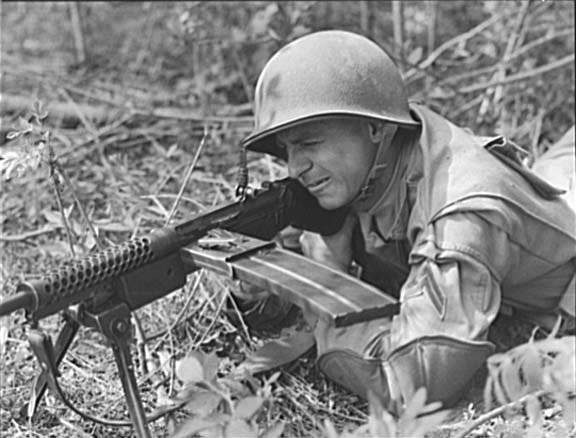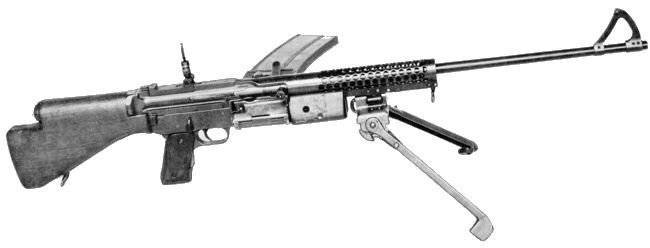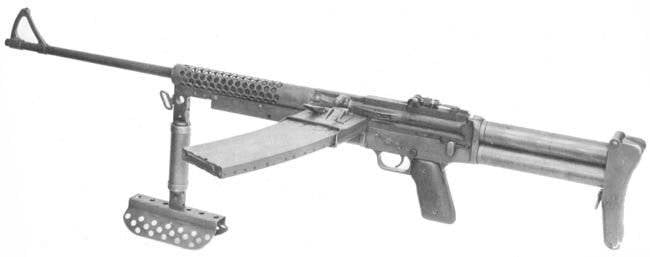American manual machine gun "Johnson" M1941

The captain of the United States Marine Corps stockpile, Melvin Maynard Johnson, developed his light machine gun at the end of the 30s. The basis was taken self-loading rifle of his own development, which for some time was a competitor to the Garand rifle. This rifle was purchased in limited quantities for the paratroopers of the marines, and was also delivered to Holland. The release of the machine gun company engaged "Cranston Arms." The rifle and machine gun had a number of unified units and parts.

The operation of the automatics is implemented according to a mixed scheme: the shutter was unlocked with a short rollback of the barrel, and the reloading operations occurred due to the inertia of the shutter (the accelerator was absent). The butterfly valve and the barrel were engaged by eight lugs, the disengagement occurred after they had passed about 3 millimeters. Tubular perforated casing was a continuation of the box. The machine gun was implemented continuous and single fire. A characteristic feature of the USM was that a single fire was made from the front sear (it allowed for greater accuracy), the fire was bursted from the rear sear (it prevented the self-ignition of the cartridge in the chamber). Adjusting the rate of fire was made by changing the force of the return spring of the shutter in the range of 300 - 900 shots per minute. On the trigger box on the right side was mounted a flag translator-fuse, installed in three positions: the front - "continuous fire", the rear - "single fire", vertical - "fuse". To reduce the “tossing” of the barrel by the designer, the “linear recoil” scheme was used, the butt was positioned on the extension of the axis of the barrel bore, and the aiming devices were mounted on high racks. The foldable sight was a separate assembly that was supplied by Marbles or Lyman. Bipod evolved back. Pistol grip and butt were wooden. For belt there were swivels.

The weight of the machine gun without the magazine was less than 6 kilogram, which was significantly less than that of the BAR. On the left there was a removable box store. A window in the right side of the box allowed recharging the magazine one at a time or from a standard clip. This modification allowed to achieve a higher combat rate of fire. Installing the store on the side allowed to increase the store's capacity, but caused fickle and strong flooding when shooting. weapons sideways. The guides for feeding the cartridge into the chamber were part of the box, not the store — this greatly increased the reliability of the power system. The barrel quickly and easily detached from the box to reduce the size of the weapon when carrying or for replacement. An experienced machine gunner spent on assembling a machine gun about 30 seconds.
The compact and lightweight light machine gun, which has a removable barrel, has become interesting for marines as well as for special forces units. However, the purchase of machine guns caused not so much the dignity of the system, as the lack of full-time BAR. Machine guns along with Johnson rifles were delivered to Holland.
The rifle and the Johnson light machine gun are known under the designation Ml941, but it does not correspond to the weapons designation scheme adopted since 30 in the Marine Corps and the Army, since the machine gun was not officially adopted. The inscription Light Machine Gun Johnson Automatics Model of 1941 on top of the receiving mouth of the box complied with the rules of the commercial market.
From cases of combat use of machine guns "Johnson" Ml941, their use is known "by the first squad of specials. Forces "and in Italy by small army subversive units.
Although the Johnson machine gun managed to earn a good reputation with the fighters, it did not manage to get out of the shadow of the BAR machine gun. Surpassing BAR in fire capabilities and being a more modern design, hastily launched into production, Johnson was inferior to the latter in reliability. Very often cases of non-removal of the liner occurred. To simplify the modification Ml944 received a single tubular bipod as well as a butt made up of a simple shoulder rest and two parallel tubes. Total released about 5 thousand. Johnson machine guns (according to other sources, up to 10 thousand.).
According to some reports, in 1950, equipment for the release of Johnson was exported to Israel. In 1952, production began. In any case, a number of Israeli modifications of the Johnson machine gun, dubbed the Dror, were released. This machine gun had a two-legged bipod and butt-type Ml944.
Specifications machine gun "Johnson" M1941:
Cartridge - 30-06 (Ml, M2);
The mass of weapons - 5,9 kg (no magazine);
The mass of weapons - 6,48 kg (with a magazine);
The length of the weapon is 1066 mm;
Barrel length - 58 mm;
The rifling of the trunk - 4 right;
Initial bullet speed - 855 m / s;
The rate of fire - 300-900 shots per minute (according to other data, 450-700 shots per minute);
Effective range - 800 m;
The power supply system is a box magazine with a capacity of 20 cartridges.
Information